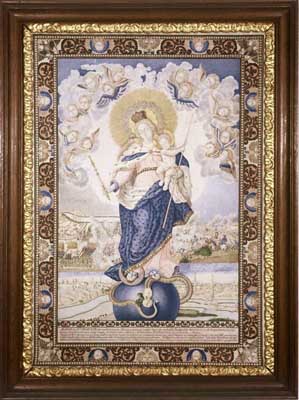Votive Picture
Picture of the Virgin Mary painted in
gratitude for the victories near Temeswar (Surrender of the
fortress on 14 October 1716) and Belgrade (16 August 1717).
Liberation of Temeswar: 1716; Anonymous,
about 1720. Pen with India Ink und brush with body colours on
parchment, 82x59 cm. The parchment is mounted on wood; profiled
wooden frame: mid-eighteenth century.
Based on the five lines of inscription, a 66
year old priest from Verona painted this picture on parchment in
two years of hard work, as an everlasting remembrance of Maria’s
help. He is asking all angels to petition Jesus and his most
holy mother Mary, the queen of heaven and author of the
victories near Temeswar and Belgrade, on behalf of himself, for
the archdukes and for the wellbeing of the ruler. He mentions
especially that a miraculous fog facilitated the victory near
Belgrade.
Both events are indicated in the lower third
of the painting, the minaret-dominated city of Temeswar with its
fortifications on the Bega, and above it, separated by the blue
horizon, the battle of Belgrade. On the left one recognizes the
Danube Bridge and the imperial encampment in front of the
fortress Belgrade. Columns of troops are just spreading out open
the battle under clouds of fog, while to the right, on the
Turkish side, there is much agitation.
This historic event actually fades into the
background, as the fog emerging on the left becomes a light
cloud, from which many heads of winged angels separate and in
front of which appears Mary with the Child. As Princess of
Heaven she is depicted with crown, sceptre, and blue,
star-studded, ermine-lined coat. Her head is surrounded by a
wreath of twelve stars. She is also the large sign in the sky
according to the secret revelation (Rev.12,1). Like the
Immaculata in uncounted baroque paintings, she is standing on
the globe entwined by snakes and places one foot on the moon
(Rev. 12,1; At the same time an allusion to the victory over the
Turkish half moon), and the other foot on sepent of paradise,
which holds the apple of Adam in its mouth.
The wars against the Turks are subsumed here
under the story of salvation in which the Woman of Promise
smashes the head of the satanic snake (Gen.3,15 Vulgata). |
|

She does that not out of her own power, but through her divine
child, which, with a powerful gesture with the cross-shaped rod deals the deathblow
to the snake.
It is customary to call this baroque type of
the Madonna “Maria from Victory”. It was, therefore, likely that
the priest from Verona would place the two wars against the
Turks under this majestic appearance of the Madonna. This
collaboration between heavenly help and imperial arms is also
suggested by the painted frame of the picture, on which
alternate, between rods of pearl, heads of winged angels and
imperial double eagles.
The Latin
text reads as follows:
Jseum, & SSm. Matrem eius victoriarum
Themisuarij, ac (mirâ fauente nebulâ) Belgradij Auctricem, coeli
Imperatricem, vos omnes Angeli orate pro nobis, votisque
Archiducum; Alleluia, & diuturna REGNANTIS incolumitate;
Alleluia.
Opus integri biennij ad perenne marianorum
munerum gratum monumentum per sacerdotem veronensem aetatis
cadentis. 66 annorum valdé laborioso calamo (DIE adiuuante
GRATIA) depictum jn charta membrana. Si dignum clementer
judicabitur: GRATIA secundum clementiam, & deuotionem jn honorem
beatae semper VIRGINIS, solitis, & ferventioribus quocunque
tempore precibus pro votis (ut suprà) recognoscenda. |